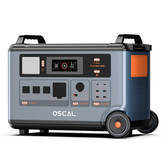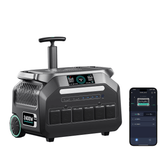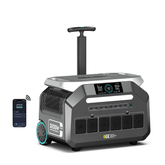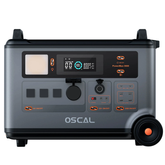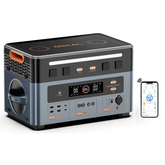Best Portable Power Station for Refrigerator
best portable power station for refrigerator — when the lights go out or you're off-grid, keeping your fridge running is more than convenience; it's food safety and peace of mind. Across Europe more households, campers, and van-lifers are asking which portable power station will reliably power a refrigerator. This guide helps EU users understand fridge power needs and why the IEE P2400 and IEE P3200 are top choices for refrigerators and home backup.
We cover what a fridge really requires (surge vs running watts), how to estimate needed battery capacity (Wh), and what features matter most for European users—plus clear runtime estimates, product recommendations, and practical buying advice.
Why You Need a Portable Power Station for Your Refrigerator
Europe's recent storms, rolling blackouts, and grid instability make backup power a smart investment—not only for outdoor lovers but for households and small businesses. A power station is silent, clean, safe indoors, and often solar-chargeable—advantages that matter especially in EU countries with strict noise and emissions rules.
Here are the key reasons to prepare:
- Food safety: Perishables spoil quickly when temperature rises above 4°C.
- Medication storage: Insulin and other drugs require stable refrigeration.
- No fuel hassles: Unlike petrol generators, battery stations are allowed in apartments and many campsites.
- Camping & vanlife: Portable fridges and coolers need clean, quiet power.
How Much Power Does a Refrigerator Need?
To choose the best portable power station for refrigerator, you must match two numbers: the fridge’s starting (surge) wattage and its running wattage. Here’s a quick reference for EU refrigerators.
| Type | Running Wattage | Surge Wattage | Daily Consumption |
|---|---|---|---|
| Mini fridge | 60–100W | 150–300W | 0.3–0.6 kWh |
| Standard household fridge | 120–200W | 600–1200W | 1–2 kWh |
| Large fridge + freezer | 200–300W | 1200–1800W | 2–3 kWh |
Surge output is critical because compressors demand a high starting current. Battery capacity (Wh) determines how long the fridge can run. Match both—don’t pick a unit that meets only one.
Top Picks: IEE P3200 & IEE P2400
Below are two IEE models that excel for fridge backup across European use cases: one for maximum power and full-home backup, the other for balanced performance and portability.
IEE P3200 — Best Overall for Full-Size Refrigerators
The IEE P3200 is engineered for users who need real home-backup capability and long runtimes for large fridges and freezers.
| Feature | Spec |
|---|---|
| AC Output | 3200W continuous, 6000W surge |
| Battery Capacity | 2048Wh (LiFePO₄) |
| Charging | AC fast charge + solar-ready up to ~1000W |
| Best for | Full-size refrigerators, family homes, long outages |
Why choose it: the P3200 handles high startup surges, powers additional household loads, and can recharge quickly with combined AC and solar inputs—ideal for EU households that require long, reliable runtimes.
IEE P2400 — Best Value for Standard Refrigerators
The IEE P2400 strikes a great balance between capacity, portability, and price. It’s perfect for apartments, mid-size fridges, and families needing reliable backup without the flagship price tag.
| Feature | Spec |
|---|---|
| AC Output | 2400W continuous, 4800W surge |
| Battery Capacity | 2048Wh (LiFePO₄) |
| Charging | Fast AC charge, solar-ready up to ~500W |
| Best for | Medium refrigerators, apartments, campers |
Why choose it: the P2400 is easier to move, offers long cycle life thanks to LiFePO₄ chemistry, and provides enough surge capacity for most European refrigerators.
Estimated Runtime Examples
Below are conservative runtime estimates based on average fridge consumption (150W running load). Real-world times vary with fridge efficiency, duty cycle, and ambient temperature.
| Model | Capacity (Wh) | Estimated Running Hours (150W fridge) |
|---|---|---|
| IEE P3200 | 2680Wh | ~30–40 hours |
| IEE P2400 | 2048Wh | ~16–24 hours |
With solar panels and effective charging strategy, both units can support much longer off-grid periods—potentially indefinite with sufficient panel wattage and sun hours.
Why EU Users Prefer Portable Power Stations Over Petrol Generators
- Noise and emissions: petrol generators are often restricted in urban or protected natural areas.
- Indoor safety: battery stations produce no fumes and can be used near living spaces.
- Environmental incentives: many EU markets offer incentives for renewable setups and solar investments.
- Convenience: instant UPS switching, app monitoring, and silent operation.
How to Choose the Right Model — Quick Checklist
- Confirm surge capacity: ensure the power station covers your fridge’s startup wattage.
- Check continuous output: continuous AC output must exceed your fridge’s running watts.
- Estimate runtime: Wh ÷ average fridge wattage = hours (allow margin).
- Prefer LiFePO₄: longer life and better thermal stability for EU conditions.
- Solar support: if off-grid or rural, ensure high solar input and MPPT controller compatibility.
- EU certifications: CE, RoHS, and local support are important for compliance and safety.
Practical Tips to Maximise Runtime and Performance
- Manage fridge temperature: keep fridge efficient—avoid frequent door openings during outages.
- Use efficient fridges: A+++ or high-efficiency models reduce energy draw significantly.
- Reduce non-essential loads: switch off extra appliances to reserve capacity for the fridge.
- Use solar wisely: position panels for maximum sun, and combine solar + AC charging when possible.
- Monitor via app: many modern units (including IEE models) offer app controls for load monitoring and power management.
Common Scenarios & Recommended Setup
Full-Size Home Fridge + Occasional Freezer Use
Recommended: IEE P3200 + 800–1200W solar array (if off-grid). This combination provides long runtime and fast recharge.
Standard Apartment Fridge (Occasional Blackouts)
Recommended: IEE P2400 — economical, portable, and well-matched for typical apartment refrigerators.
Camping / Vanlife with Portable Fridge
Recommended: IEE P2400 with 200–400W portable panels for weekend trips; consider the P3200 only if running additional high-load devices.
Installation & Safety Notes for EU Users
- Always check manufacturer guidance for UPS wiring and automatic transfer switches.
- Do not exceed continuous or surge ratings—overload can trip protection circuitry.
- Store batteries at recommended temperatures for longevity (generally 10–25°C).
- Use certified cables and connectors for solar input; follow EU electrical codes where applicable.
Final Thoughts — Which Is the Best Portable Power Station for Refrigerator?
If you’re searching for the best portable power station for refrigerator in the EU, your decision hinges on fridge size and how long you need backup power. For families and full-size fridges, the IEE P3200 is the premier choice—high continuous output, massive surge capability, and extended runtime. For most apartments, campers, and mid-size fridges, the IEE P2400 delivers outstanding value, safety, and portability.
Both models use LiFePO₄ chemistry, offer strong solar compatibility, and meet the practical needs of European users looking for clean, quiet, and reliable refrigerator backup. Choose the model that matches your fridge’s surge and running requirements, and pair it with an appropriate solar array if you need extended off-grid power.
When the lights go out, your fridge shouldn’t fail you. With the right portable power station—whether the IEE P2400 or the IEE P3200—you’ll keep food safe and gain true peace of mind.

